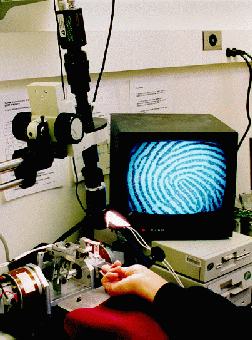  Although
physical contact is ubiquitous in our interactions with objects in the environment,
we do not yet understand the mechanistic phenomena occurring at the skin-object
interface. When we touch an object, the source of all tactile information
is the spatio-temporal distribution of mechanical loads on the skin at the
contact interface. The relationship between these loads and the resulting
stresses and strains at the mechanoreceptive nerve terminals within the
skin plays a fundamental role in the neural coding of tactile information.
The loads, specified as pressure, displacements, etc., depend on the geometrical
and material properties of both the contacting entities, as well as the
overall forces of interaction. Although empirical determination of the stress
or strain state of a mechanoreceptor is not possible at present, mechanistic
models of the skin and subcutaneous tissues enable generation of testable
hypotheses on skin deformations and associated peripheral neural responses.
Verification of the hypotheses can then be accomplished by comparing the
calculated results from the models with biomechanical data on the deformation
of skin and subcutaneous tissues, and neurophysiological data from recordings
of the responses of single neural fibers. The research in this project is
directed towards applying analytical and computational mechanics to analyze
the biomechanical aspects of touch - the mechanics of contact, the transmission
of the mechanical signals through the skin, and their transduction into
neural impulses by the mechanoreceptors. Although
physical contact is ubiquitous in our interactions with objects in the environment,
we do not yet understand the mechanistic phenomena occurring at the skin-object
interface. When we touch an object, the source of all tactile information
is the spatio-temporal distribution of mechanical loads on the skin at the
contact interface. The relationship between these loads and the resulting
stresses and strains at the mechanoreceptive nerve terminals within the
skin plays a fundamental role in the neural coding of tactile information.
The loads, specified as pressure, displacements, etc., depend on the geometrical
and material properties of both the contacting entities, as well as the
overall forces of interaction. Although empirical determination of the stress
or strain state of a mechanoreceptor is not possible at present, mechanistic
models of the skin and subcutaneous tissues enable generation of testable
hypotheses on skin deformations and associated peripheral neural responses.
Verification of the hypotheses can then be accomplished by comparing the
calculated results from the models with biomechanical data on the deformation
of skin and subcutaneous tissues, and neurophysiological data from recordings
of the responses of single neural fibers. The research in this project is
directed towards applying analytical and computational mechanics to analyze
the biomechanical aspects of touch - the mechanics of contact, the transmission
of the mechanical signals through the skin, and their transduction into
neural impulses by the mechanoreceptors.
|
Click on the following links to read more in specific areas.
|
|


